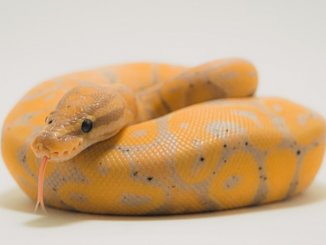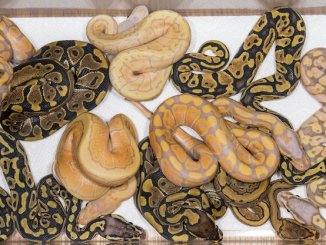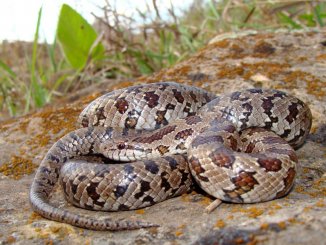The viper boa is a small species of snake native to the forests, swamps, and wet lowlands in New Guinea. These snakes are known for their resemblance to Papuan death adders and have blunt noses, triangular heads, and distinctive keeled scales.
While non-venomous, viper boas are moderately difficult to keep because of their need for high humidity. The snakes aren’t common in the pet trade and not much is known about their behavior in the wild.
Viper Boa Overview
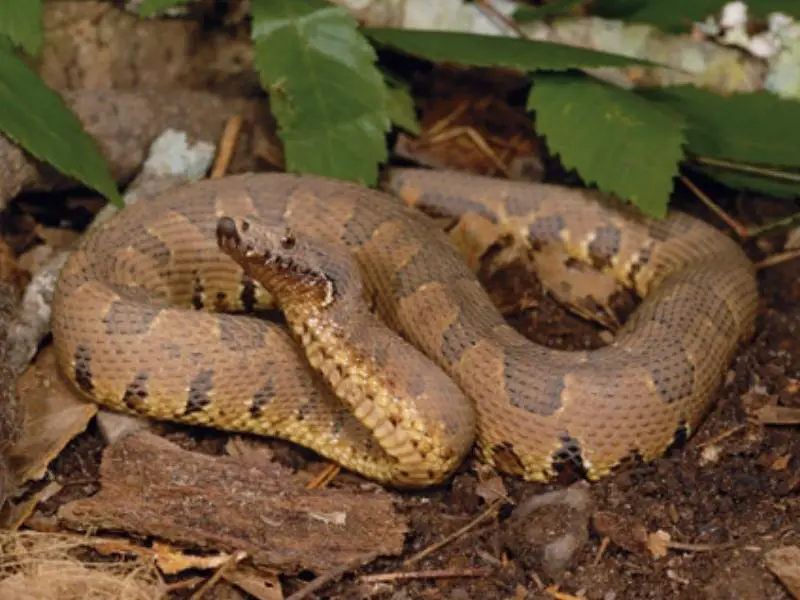
| Common name | Viper boa, New Guinea ground boa |
| Scientific name | Candoia aspera |
| Natural habitat | Forests, swamps, wet lowlands in New Guinea and some Indonesian islands |
| Adult size | Up to 3 feet |
| Average lifespan | Up to 15 years |
| Diet | Carnivore |
| Housing | 3 feet x 2 feet x 1.5 feet enclosure with plenty of floor space. Temperature gradient of 78 to 90°F and humidity between 70% and 80% |
| Experience level | Intermediate |
Origin
The viper boa (Candoia aspera) is native to New Guinea and some Indonesian islands, where it inhabits swamps, forests, plantations, and wet lowlands. These places are densely-vegetated, humid, and often experience seasonal flooding.
The viper boa is nocturnal, terrestrial (ground-dwelling), and spends most of its time hidden among leaf litter, loose soil, or debris. The snake’s wild population is considered stable by the International Union for Conservation of Nature (IUCN).
Appearance and Behavior
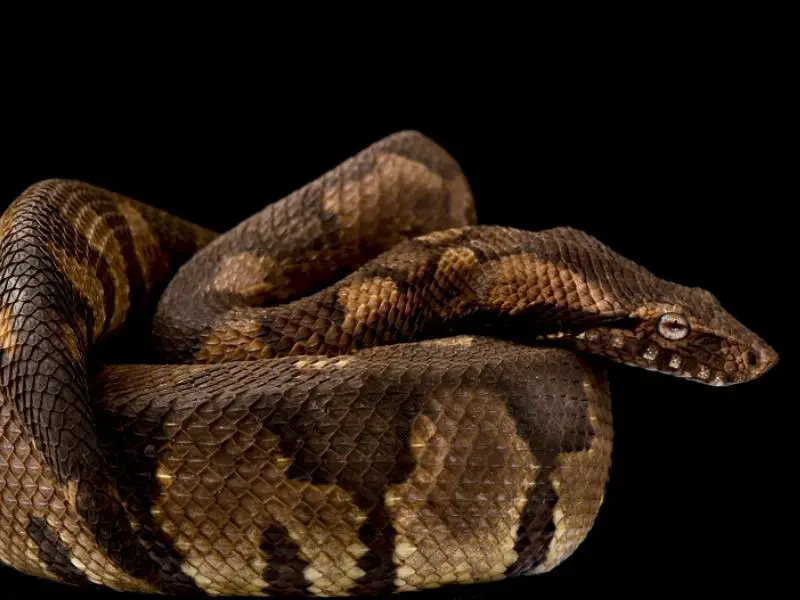
The viper boa is a small snake that gets its name from its viper-like appearance. The snake has rough keeled scales, a stocky body, triangular-shaped head, and a blunt nose.
The snake is usually dark in coloration and has distinct blotches that spread across its body. These colors help the viper boa stay camouflaged in the wild. The snake’s belly is typically a light shade of cream or tan.
The sexes are easy to distinguish because males are smaller than females and have long, pointed spurs.
Viper boas are similar in appearance to Papuan death adders, though the two species have different head shapes and markings. Some viper boas have bands instead of blotches and can even appear in vibrant shades of red, gold, and orange. Selectively-bred color morphs are rare.
Size and Lifespan
Adult viper boas grow up to 3 feet long, with the tail making up less than 10% of their total body length. Males reach 16 inches and females reach 24 inches.
With the right care and enclosure conditions, viper boas can live for up to 20 years in captivity. Not much is known about this species’ lifespan in the wild.
Temperament
Wild-caught viper boas are aggressive, prone to stress, and uncomfortable around humans. Viper boas bred in captivity are even-tempered and generally peaceful. With proper socialization from a young age, these snakes rarely bite and can be handled for brief periods.
This species is nocturnal and hunts at night. During the day, the snakes spend most of their time burrowed within the substrate. These snakes are excellent swimmers and enjoy soaking in water.
Viper boas are territorial and should be kept in individual enclosures to prevent aggression. When stressed or threatened, the snakes typically hide or curl up into a ball.
Housing Viper Boas
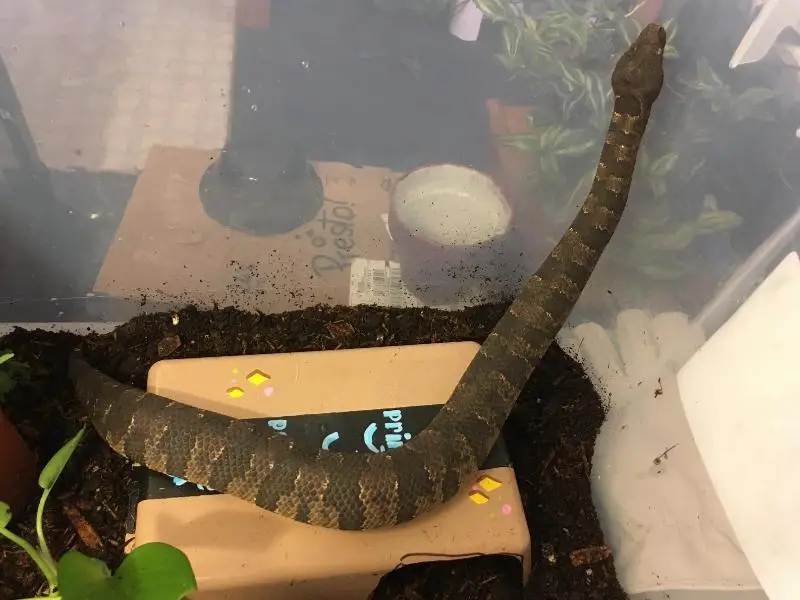
Viper boas thrive in moist and humid regions in New Guinea. These snakes often inhabit forests, wet lowlands, and swamps, and are accustomed to dense vegetation and soft soil.
Replicating the viper boa’s natural habitat will help the snake live a long, happy, and healthy life. Invest in a terrarium with plenty of floor space. Keep the enclosure humid, incorporate foliage, and establish a temperature gradient.
Enclosure size
Adult viper boas require a terrarium that measures at least 3 feet x 2 feet x 1.5 feet in size.
These snakes are terrestrial and rarely climb, so they need much more floor space than vertical space. However, the terrarium should still be tall enough to accommodate a deep substrate.
Opt for a glass or plastic enclosure instead of a wooden enclosure because wood rots when exposed to high humidity.
Lighting
Viper boas are nocturnal snakes, so they don’t require UVB lighting. Use a low-wattage bulb and replicate a natural day-night cycle by providing 12 hours of light per day. Install a timer to ensure the light cycle remains consistent.
Natural light is another alternative, but never expose the enclosure to direct sunlight. Strong sunlight will affect the temperature and cause the snake to become stressed, lethargic, or sick.
Temperature and Humidity
Viper boas are ectothermic (cold-blooded), so provide both cool and hot zones in the enclosure to allow these snakes to regulate their internal body temperature by moving around.
The hottest spot should be around 85°F, while the rest of the enclosure should stay between 78 and 80°F. During the night, the temperature shouldn’t drop below 75°F.
An under-tank heating pad with thermostat control is ideal to keep the hot zone at the right temperature without affecting the lighting or putting the snake at risk of thermal burns.
The humidity must stay between 70% and 80%. Mist the enclosure daily and add live plants (a bioactive setup) to keep humidity levels high. You should also provide humid hides — containers with moisture-holding substrate — to prevent shedding problems.
Use a hygrometer to monitor humidity levels, and increase ventilation if the humidity goes above 80%. The substrate should always be moist to the touch, but never soggy.
Substrate and Decoration
Cypress mulch, coconut musk, and potting soil are ideal substrates because they’re pliable, soft, widely available, and hold moisture well. Avoid lining the enclosure with abrasive materials like gravel, and scatter sterilized leaf litter above the substrate to simulate the viper boa’s natural habitat.
The substrate should be at least 3 inches thick to allow the snake to properly burrow.
Provide viper boas with plenty of hiding spots to help the snakes feel at ease. Set up hiding areas using slate, driftwood, cork bark, and plants. Suitable live plants include small ficus, scindapsus, fern, and spider plants. Branches aren’t necessary because viper boas rarely climb.
Provide a water bowl in the enclosure that is large enough for the snake to soak in. Ensure the dish is accessible and can’t be toppled over.
Cleaning
Keeping the viper boa’s enclosure clean helps prevent diseases. Spot clean the enclosure regularly to remove waste, leftover food, shed skin, and soiled substrate.
Deep clean the enclosure once a month. Replace the substrate and wipe down the enclosure’s walls, base, and decorations with warm water and a reptile-friendly disinfectant. The viper boa should be removed and kept in a separate enclosure during deep cleaning.
Never use harsh, chemical-based products like bleach, as these are highly toxic and can be lethal for snakes.
Viper Boa Care
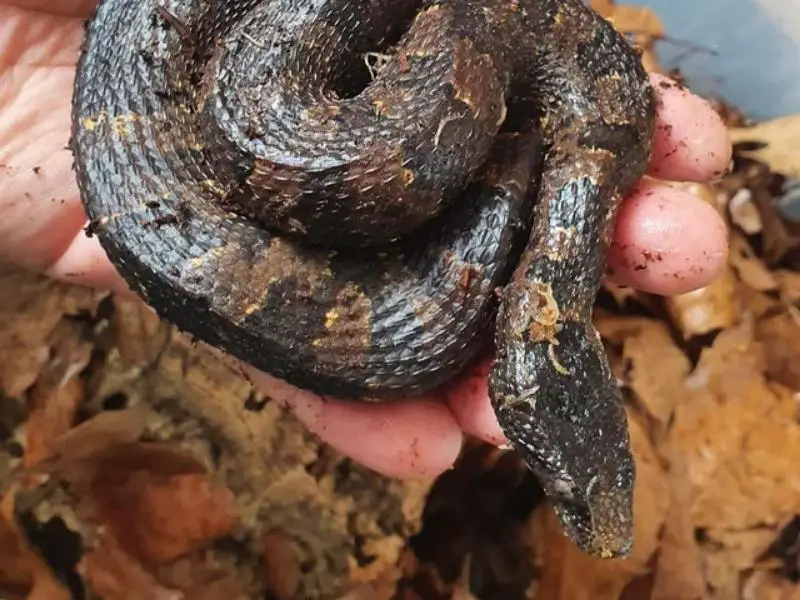
Viper boas are best suited to intermediate and experienced reptile keepers. These snakes need high humidity — which an inexperienced hobbyist may struggle to maintain — and are timid and easily stressed.
Food and Water
Viper boas are carnivores that eat a variety of food in the wild, including small mammals, reptiles, amphibians, and fish. In captivity, these snakes should be fed fully-thawed rodents and occasionally feeder fish and lizards as a treat.
Adult viper boas have slow metabolisms and only need to be fed one rodent every two to three weeks, while juveniles should be fed a pinky mouse once a week to support their growth.
Use soft-tipped tongs to place food into the enclosure and ensure each meal is smaller than the widest point of the snake’s body. Avoid live prey, which can injure viper boas, harbor parasites, and are difficult to maintain. Offer food when it’s dark because these snakes are nocturnal and hunt at night.
Change the water daily, and clean the bowl thoroughly with reptile-friendly disinfectant if the snake defecates inside it.
Handling
A captive-bred viper boa can be handled as long as it’s been exposed to human touch from an early age. Use a hook to remove the snake from its enclosure and support its full body weight while handling.
Wash your hands before and after touching viper boas, and avoid handling them if they’re shedding or have just eaten. Wild-caught viper boas shouldn’t be handled because they aren’t accustomed to humans and are often aggressive.
Keep handling sessions under 15 minutes. Overhandling can lead viper boas to become stressed, startled, and even aggressive. While non-venomous, these snakes have sharp teeth, making bites painful. Clean bite wounds immediately with antiseptic wipes to prevent infection.
Loud noises and sudden movements startle viper boas. Handle these snakes in quiet, peaceful environments and never let them roam freely across the floor.
Common Health Issues
Common health issues that affect viper boas include mouth rot, respiratory infections, skin disorders, and internal parasites. Snakes rarely show obvious signs of sickness, so be vigilant and perform regular physical checkups.
- Mouth rot: An infection that causes mouth inflammation. Often caused by stress or poor enclosure conditions. Treatment depends on the cause, but typically involves proper husbandry, antibiotics, and surgery
- Respiratory infection (RI): An infection that causes excess mucus, wheezing, nasal discharge, lethargy, and appetite loss. Most respiratory infections are treatable with antibiotics and nose or eye drops
- Skin disorders: Disorders that hinder shedding and cause the snake’s skin to appear dry, flaky, patchy, and irritated. The most common cause is inappropriate humidity levels. Check humidity in the enclosure with a hygrometer and treat with antibiotics if necessary
- Internal parasites: Parasites that can spread through fecal matter and live food and lead to internal swelling, weight loss, regurgitation, and lethargy. Treatable with deworming medication
- Obesity: Excessive weight gain caused by overfeeding. Viper boas have slow metabolisms and can put on weight quickly. Only feed adult viper boas snakes once every two to three weeks
Breeding
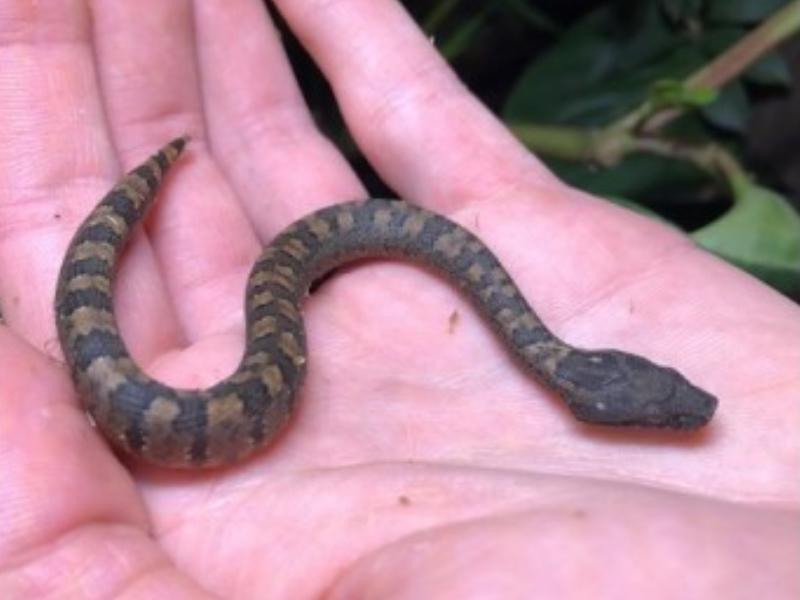
Viper boas are fairly difficult to breed in captivity, though not impossible. These snakes reach sexual maturity at three to four years old and produce around 10 to 20 babies on average.
Follow the steps below to breed a pair of viper boas:
- The snakes need to first undergo a cooling-off period (brumation) to prepare for breeding. At the start of November, gradually lower the enclosure’s ambient temperature to 70°F and change the night-day cycle to reflect winter (around nine hours of light per day). Reduce feeding to once every three to four weeks
- In January, gradually increase the temperature again, offer more food, and provide 12 hours of light per day
- Introduce the male to the female’s enclosure. Ensure the terrarium is warm and has plenty of hiding spots, a large water bowl, and a soft substrate. Males and females must be well-fed and healthy to reduce the chances of aggression
- If the pair become hostile or show signs of distress, separate them and try again at a later time
- Gravid female viper boas will swell up and go off their food. These snakes give birth to live young and the gestation period typically lasts seven to nine months
- Remove the babies immediately once the female viper boa has given birth
- Keep babies in separate 5-gallon enclosures and provide a temperature gradient, water bowl, small hide, and a paper towel substrate. Offer small pinky mice
Only breed females once every two years to give them time to recover and return to healthy body weight. Multiple males (up to four) can be introduced into the female’s enclosure to improve the chances of success, though the enclosure must be spacious.
Males must also be monitored at all times because aggressive wrestling behavior can occur. Once the female has chosen and paired with a male, remove the other snakes.
Choosing and Buying a Viper Boa
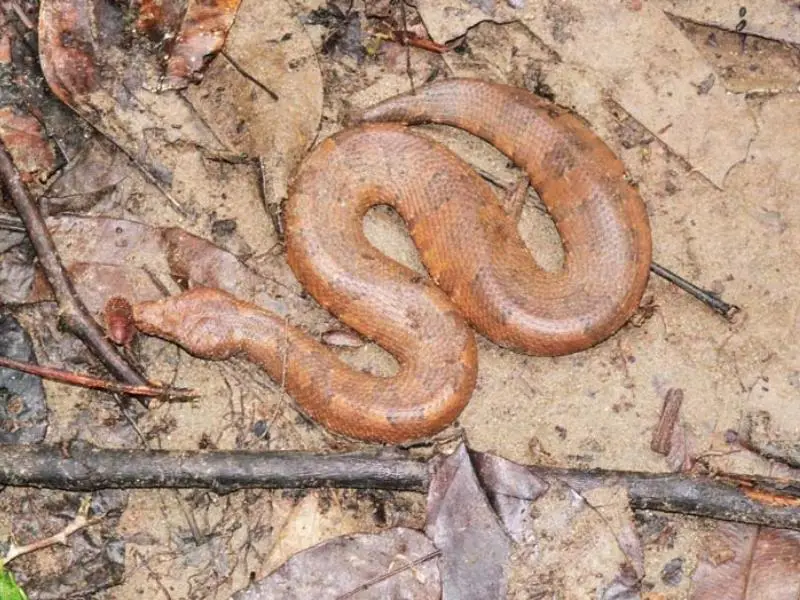
Viper boas are moderately expensive and cost between $150 to $300 depending on age, color, size, sex, and whether they’re wild-caught or captive-bred. These snakes can be bought from reputable breeders or online reptile stores including:
A license isn’t needed to own these snakes, though wild-caught viper boas are aggressive and prone to stress, making them harder to keep than captive-bred viper boas.
Healthy viper boas have bright eyes, stocky bodies, and strong coloration. Avoid snakes that are lethargic or look thin and dull.

